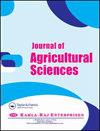PCR Based Approach for Detection of Bovine Babesiosis in Suspected Carrier Cattle and Vector Ticks in Sri Lanka
IF 0.7
Q3 AGRICULTURE, MULTIDISCIPLINARY
引用次数: 0
Abstract
Purpose: Cattle recovered from clinical babesiosis become carriers for a certain period posing a threat of transmitting the disease to the entire herd. Diagnosis of carrier cattle is important for preventing outbreaks of babesiosis. The objective of the present study therefore, was to establish a sensitive rapid detection method for bovine babesiosis in suspected carrier cattle using nested PCR (nPCR). Research Method: Accordingly, 30 blood samples and ticks were collected from suspected carrier cattle representing two bio-climatic zones of Sri Lanka. Blood samples were analysed by both microscopically and nested nPCR methods for detection of bovine babesiosis. Further ticks were analysed for morphological idenfication using micrscopy and for babesiosis with nPCR. Findings: 47% (14/30) among the investigated samples became positive for the babesia infection with light microscopy, while nPCR analysis diagnosed 90% (27/30) as positive. This indicates that, 43% (13/30) of the animals which appeared to be healthy through routine light microscopical diagnosis were in fact carriers posing a major threat to the healthy herd. Further, according to the results of nPCR, 22% (6/27) of the blood samples were positive only for Babesia bovis infection, 11% (3/27) only for Babesia bigemina infection and 67% (18/27) for mixed infection with both parasites. The dominant tick vector isolated from both zones was Rhiphicephalus microplus. Out of the examined ticks, 21% (5/24) were positive for Babesia bigemina infection. Research limitations: Since the sample size from all sites of both climatic zones were uneven and small, data could not be analysed for statistical significance. Originality/Value: However, the results from this study indicate that nPCR provides a sensitive screening method to detect bovine babesiosis compared to the conventional microscopic analysis.斯里兰卡疑似携带牛和媒介蜱巴贝斯虫病的PCR检测方法
目的:从临床巴贝斯虫病康复的牛在一段时间内成为携带者,构成将疾病传播给整个牛群的威胁。诊断带菌牛对预防巴贝斯虫病暴发很重要。因此,本研究的目的是建立一种利用巢式PCR (nPCR)快速检测牛巴贝斯虫病的方法。研究方法:因此,从代表斯里兰卡两个生物气候带的疑似携带牛身上采集了30份血液样本和蜱虫。采用显微法和巢式nPCR法对血样进行分析,检测牛巴贝斯虫病。进一步用显微镜对蜱进行形态鉴定,用nPCR对巴贝斯虫病进行分析。结果:光镜下巴贝虫感染阳性率为47% (14/30),nPCR检测阳性率为90%(27/30)。这表明,43%(13/30)通过常规光镜诊断显示为健康的动物实际上是对健康畜群构成重大威胁的携带者。此外,根据nPCR结果,22%(6/27)的血液样本仅为牛巴贝虫感染阳性,11%(3/27)的血液样本仅为双巴贝虫感染阳性,67%(18/27)的血液样本为两种寄生虫混合感染阳性。两区分离到的优势蜱媒均为微头蜱。检出蜱中有21%(5/24)感染巴贝斯虫。研究局限:由于两个气候带所有站点的样本量不均匀且较小,因此无法对数据进行统计显著性分析。独创性/价值:然而,本研究的结果表明,与传统的显微镜分析相比,nPCR提供了一种灵敏的筛选方法来检测牛巴贝斯虫病。
本文章由计算机程序翻译,如有差异,请以英文原文为准。
求助全文
约1分钟内获得全文
求助全文
来源期刊

Journal of Agricultural Sciences
AGRICULTURE, MULTIDISCIPLINARY-
CiteScore
1.80
自引率
0.00%
发文量
0
 求助内容:
求助内容: 应助结果提醒方式:
应助结果提醒方式:


